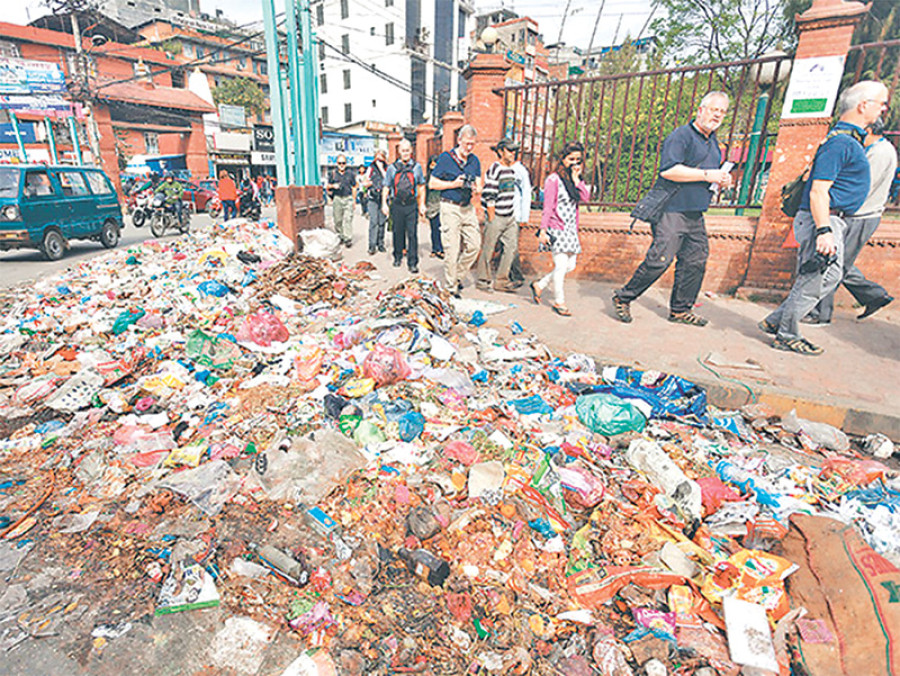Opinion
Circular economy
Where products are designed for ease of recycling, reuse and remanufacturing
Anoj Chhetri
The approach paper to the 14th periodic plan (fiscal years 2016-17 to 2018-19) has placed heavy emphasis on economic development. Towards this end, it has outlined critical strategies for generating employment because unless jobs are created on a massive scale, youth migration cannot be stopped, and the government’s ambitious plan to reduce poverty and lift Nepal out of its least developed country (LDC) status may stall. One of the tough requirements that Nepal has to fulfil for graduation from LDC status is increasing the annual per capita income from the current $902 to $1,242. And while it is most important for the government to invest adequate resources in infrastructure development, some affluent people have developed the habit of excessive consumption partly due to the rising flow of remittance.
One of the manifestations of this trend can be seen in our bio-physical environment. Polluting plastic, bottles, hardware and stinking garbage can be seen littered all over in both rural and urban areas. Garbage piles in high mountain areas, major trekking trails and even near a serene lake like Rara are not exceptions. The government should look at the potential impact of remittance on consumptive behaviour, unplanned economic activities and improper resource balance. The focus on asset creation by investing in productive infrastructure and development of skills and linkages with productive resources should not disregard the shift from traditional habits like eating nutritious minor crops (buckwheat, millet andbarley) and reusing scarce natural and man-made resources. Therefore, new ways of thinking to create economic opportunities through thoughtful investment in productive sectors are needed.
A new paradigm for green growth and employment creation is a ‘circular’ industrial system that is restorative by intention and design. The idea is that rather than discarding products before their value is fully utilised, we should use and reuse them. The proposition is that a circular economy, where products are designed for ease of recycling, reuse, disassembly and remanufacturing, should replace the traditional, linear ‘take, make and dispose’ model that has dominated the economy since the beginning of the Industrial Revolution.
The benefits of a circular economy can be best seen in countries like Nepal on the three pathways towards sustainable economic development: renewable energy, energy efficiency and material efficiency. By organising manufacturing along the lines of a ‘materially-efficient-performance-based economy’, that is by minimising waste and maximising the reuse and recycling of materials, countries can cut carbon emissions significantly, and in addition, create a number of additional jobs for outbound Nepali youths. In this context, the government of Nepal should study the principles of a circular economy and lead the country towards sustainable development by addressing emerging issues of climate change and environmental degradation. Look at the pollution level in the Kathmandu Valley and its impending heavy impact on people’s health.
The government should pursue a policy of upscaling micro and mini enterprises based on the paradigm of a circular economy by building linkages and trust with civil society, the private sector and the international community. Carbon finance capacity development activities should be built into local level planning processes in order to leverage donor investment in the larger interest of climate change, mitigation measures and restorative actions.The promotion of approaches to reduce emissions through increased recycling and lowered use of fresh raw materials will create an enabling environment for an improved manufacturing sector and backward and forward linkages. It will ultimately help countries like Nepal mitigate the impact of pollution and climate change and protect the gains of investing in infrastructure development.
Therefore, Nepal should also exert adequate moral pressure not only on its citizens but also on fast developing countries to develop material efficiency assessment across supply chains. This will help generate additional energy for power deficient communities and address structural and political challenges that were highlighted by the recent economic blockade of Nepal by India. For example, methane emissions can be harnessed through composting by properly managing waste in Kathmandu and other large cities. Additionally, the government should assess realistic potential revenues from carbon markets and how they can be invested in improved and efficient waste management processes. It should develop a business model across sectors, taking carbon revenues into consideration with a focus on private sector involvement. Needless to say, the cost calculation should be based on internal rates of return for the specific intervention.
Chhetri is the deputy managing director of the South Asia School of Rural Reconstruction




 10.12°C Kathmandu
10.12°C Kathmandu










